Astronomers stunned by three Earth-sized planets orbiting two suns Science Daily - November 12, 2025
Three Earth-sized planets found orbiting both stars in TOI-2267 are rewriting the rules of planet formation. Remarkably, planets transit around both stars - a first in astronomy. The system’s compact, cold nature defies conventional theories of planetary formation. Future studies using JWST and other advanced telescopes could reveal what these worlds are truly made of.
NASA's tally of planets outside our solar system reaches 6,000 PhysOrg - September 18, 2025

The official number of exoplanets - planets outside our solar system - tracked by NASA has reached 6,000. Confirmed planets are added to the count on a rolling basis by scientists from around the world, so no single planet is considered the 6,000th entry. The number is monitored by NASA's Exoplanet Science Institute (NExScI), based at Caltech's IPAC in Pasadena, California. There are more than 8,000 additional candidate planets awaiting confirmation, with NASA leading the world in searching for life in the universe.
Rogue Planets Floating in Space Appear to Be Forming Their Own Moons Science Alert - August 20, 2025

Free-floating, planetary-mass objects that are just drifting carefree through the galaxy, untethered and starless, appear to be able to generate their own systems of moons, like a planetary system on a miniature scale.
Building Blocks of Life Discovered Circling a Baby Star Science Alert - August 17, 2025

Molecules capable of forming the precursors to sugars and amino acids have been detected, for the first time, in the disk of dust and gas whirling around a newborn star. The detection is tentative, but it offers a window into how complex life gets its start from the chemistry in space, not just before planets are born, but even before the formation of the stars.
Trump's "One, Big Beautiful Bill Act" includes $1 billion for the U.S. Space Force (USSF) X-37B military spacecraft program. Live Science - July 19, 2025

A Handshake in Orbit 50 Years Ago Transformed the Space Race NYT - July 14, 2025

Some 140 miles above France, American astronauts opened a spacecraft hatch and found themselves face to face with cosmonauts from the Soviet Union.
'Space ice' is less like water than previously thought PhysOrg - July 8, 2025

"Space ice" contains tiny crystals and is not a completely disordered material like liquid water, as previously assumed. Ice in space is different from the crystalline (highly ordered) form of ice on Earth.
Ice in Space Could Do Something We Thought Was Impossible - Create Crystals Science Alert - July 7, 2025
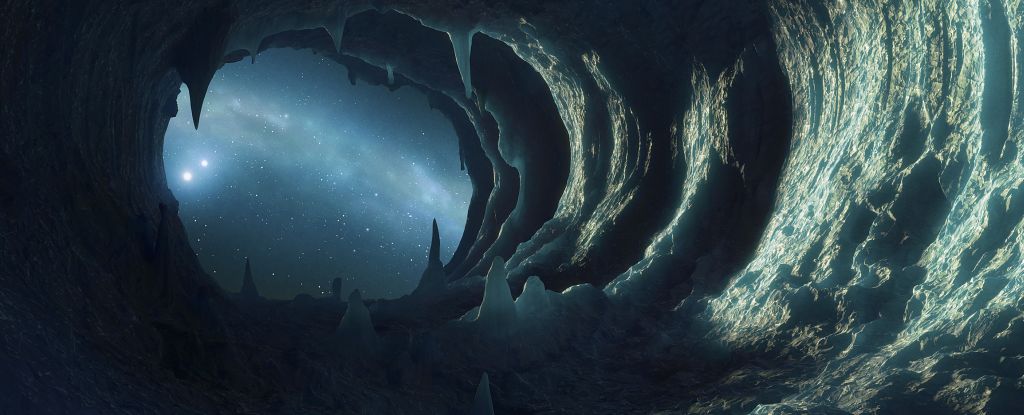
A new research effort using computer simulations and experiments to explore the most common form water takes in the Universe has found that it is not as structureless as scientists had thought. Rather, repeating patterns – otherwise known as crystals – just a few nanometers across are likely embedded in an otherwise frozen jumble of molecules.
It's Official: NASA Confirms New Interstellar Object Is Zooming Through Solar System Live Science - July 4, 2025
It's Official: NASA Confirms New Interstellar Object Is Zooming Through Solar System Science Alert - July 4, 2025
50 Years Later Mysterious Radio Signal Caught Bursting From Long-Dead NASA Satellite Science Alert - June 26, 2025

The Cosmic Owl: Astronomers discover a peculiar galaxy merger PhysOrg - June 19, 2025

An international team of astronomers reports the detection of a peculiar merger of two similar ring galaxies that morphologically resemble an owl's face. The discovery of this galaxy merger, dubbed the "Cosmic Owl" . Galaxy mergers play a crucial role in the evolution of galaxies. These events redistribute the gas around galaxies, impact the stellar kinematics, transform galaxy morphology, and eventually lead to effective stellar mass assembly.
Water Discovered Around a Young, Sun-Like Star For First Time Science Alert - June 3, 2025

For decades it was thought that water was prevalent in the outer reaches of the Solar System early in its history, with comets and asteroids delivering moisture to Earth and the inner planets during the Late Heavy Bombardment period around 4 billion years ago. An abundance of ice in places like the Kuiper Belt - the ring of 'iceteroids' in the outer Solar System - supports the idea. However, the hypothesis could not be tested until it became possible to study extrasolar systems in the early stages of formation. Thanks to the JWST, scientists finally have hard evidence that this theory is correct. According to a recent study led by researchers from Johns Hopkins University (JHU), the space telescope detected water ice in the debris disk that orbits HD 181327, a Sun-like star 155 light-years from Earth.
Mysteriously Perfect Sphere Bubble Spotted in Space by Astronomers Science Alert - May 19, 2025
>

Our Milky Way galaxy is home to some extremely weird things, but a new discovery has astronomers truly baffled. In data collected by a powerful radio telescope, astronomers have found what appears to be a perfectly spherical bubble. We know more or less what it is - it's the ball of expanding material ejected by an exploding star, a supernova remnant - but how it came to be is more of a puzzle.
Earth has four seasons, but do other planets in our solar system also have hot summer days and cold winter nights? Live Science - May 6, 2025

Other planets, dwarf planets and moons in our solar system do have seasonal cycles - and they can look wildly different from the ones we experience on Earth
Webb confirms the coldest planet ever found. It's orbiting a white dwarf PhysOrg - May 1, 2025

/Users/elliecrystal/Desktop/index.html In 2020, astronomers detected WD 1856+534 b, a gas giant that orbits a star 81 light-years from Earth. This exoplanet, which is roughly six times the mass of Jupiter (making it a "super-Jupiter"), was the first transiting planet known to orbit a white dwarf (WD) star. In a recent paper, an international team of astronomers describes their observations of this exoplanet using the Mid-Infrared Instrument (MIRI) aboard the James Webb Space Telescope (JWST). Their observation confirmed that WD 1856+534 b is the coldest exoplanet ever observed.
At 1.3 Billion Light-Years Wide, Quipu Is Officially The Biggest Thing in The Universe Science Alert - February 6, 2025

Quipu is named after an Incan measuring system.
International team captures direct high-definition image of the 'cosmic web' PhysOrg - February 5, 2025

New Hubble data has shown at least some of the carbon that now makes up our bodies may once have drifted hundreds of thousands of light-years out of the galaxy and back Science Alert - January 9, 2025
A new study shows that carbon ventures out of the galaxy itself, into a huge cloud of surrounding gas called the circumgalactic medium (CGM), before returning.
NATO Is Making A Hybrid Space-Linked Internet System In Case of Disaster IFL Science - January 6, 2025
Russia's space weapon: Anti-satellite systems are indiscriminate, posing a risk to everyone's spacecraft PhysOrg - February 26, 2024
There is, however, the very real possibility that it would also destroy the space assets of the nation behind the attack, as well as allies and friends of that same nation. This could lead to tensions being raised and lead to a loss of that country's support. The inability to control the effects of attacks in space, whether they originate from a weapon in space or on the Earth, makes such actions subject to a great degree of consideration and debate in all nations that are active in the space domain.
Scientists identify water molecules on asteroids for the first time PhysOrg - February 12, 2024
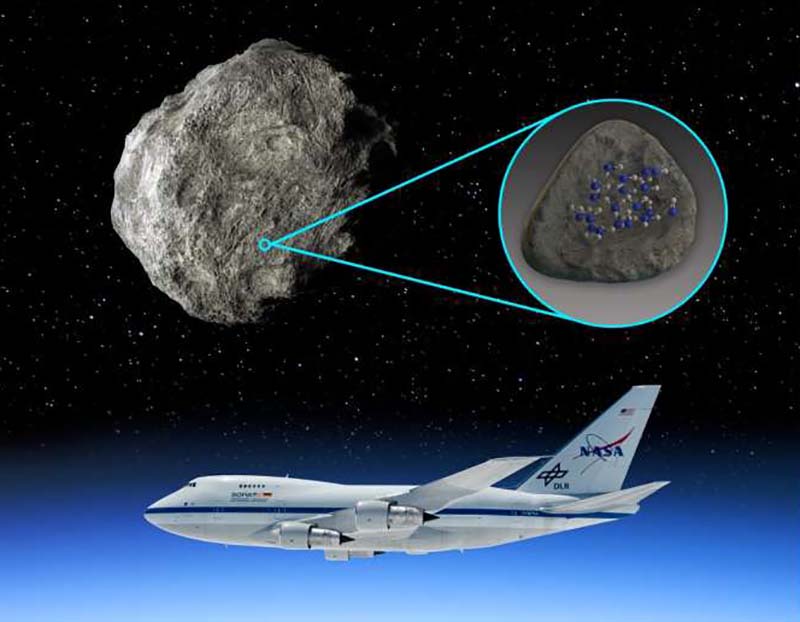
Scientists looked at four silicate-rich asteroids using the FORCAST instrument to isolate the mid-infrared spectral signatures indicative of molecular water on two of them. Asteroids are leftovers from the planetary formation process, so their compositions vary depending on where they formed in the solar nebula.
"Impossible" Worlds Are Popping Up Everywhere IFL Science - December 21, 2023
There’s a lot of diversity when it comes to the planets in the Solar System, but we can fit them into broad categories, linking them with similar formation histories and evolutions. Maybe we will come to realize that we are the odd one out, but some of the stuff out there is truly weird.
Could This Ancient Carved Disk Be The Oldest Ever Map Of The Stars? IFL Science - January 3, 2024
At first glance, this stone recovered from the site of an ancient hillfort in northern Italy appears to be just a simple disk. But, on closer inspection, its surface is peppered with chisel marks that an archaeologist and an astronomer now believe could be the oldest celestial map ever found.
Counter Earth: The Belief There Is Another Earth On The Other Side Of The Sun IFL Science - July 21, 2023

There is an idea, first proposed thousands of years ago by Greek philosopher Philolaus, that behind the Sun where we can't see it there lurks a "counter-Earth", named Antichthon.
JWST Has Found Life's Elemental Building Blocks in The Depths of Darkest Space Science Alert - January 28, 2023
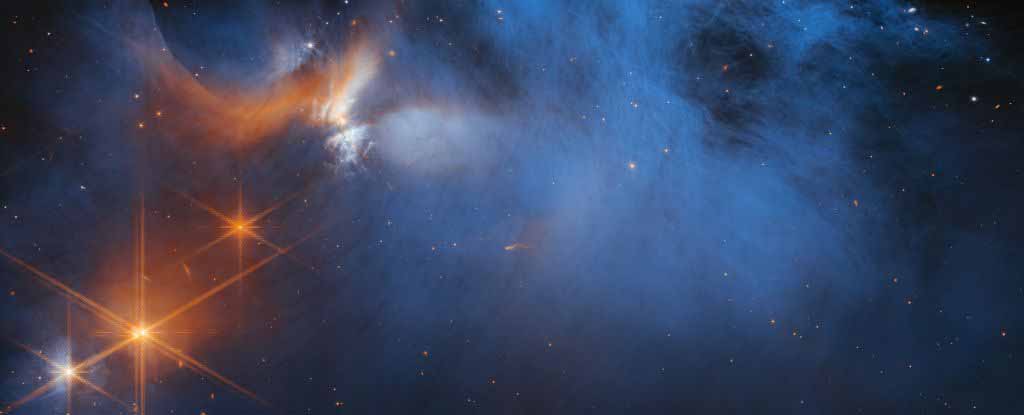
JWST's unparalleled ability to peer into the shrouded hearts of distant clouds has revealed the elements of biochemistry in the coldest and darkest place we've seen them yet. In a molecular cloud called Chamaeleon I, located over 500 light-years from Earth, data from the telescope has revealed the presence of frozen carbon, hydrogen, oxygen, nitrogen, and sulfur - elements vital to the formation of atmospheres and molecules such as amino acids, collectively known as CHONS. These elements are important components of prebiotic molecules such as simple amino acids - and thus ingredients of life, so to speak.
Elusive 'Buchdahl stars' are black holes without event horizons. These hypothetical stars are the densest objects in the universe that can exist without becoming full-fledged black holes Live Science - January 16, 2023
An elusive object in space has posed a riddle for scientists. It looks like a black hole. It acts like a black hole. It may even smell like a black hole. It has one crucial difference: It has no event horizon, meaning that you can escape its gravitational clutches if you try hard enough. But no one has ever observed one, leading to questions about whether the mysterious objects actually exist. Now, a physicist may have uncovered a new property of Buchdahl stars that could help to answer that.
Astronomers Have Spotted a Record-Breaking Magnetic Field in Space, And It's Epic Science Alert - July 16, 2022
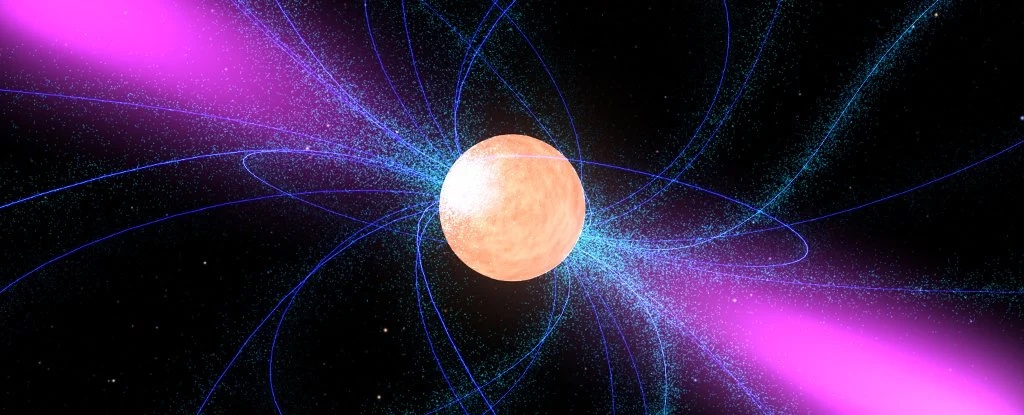
Far out in the Milky Way, roughly 22,000 light years from Earth, a star unlike any other roars with a magnetic force that beats anything physicists have ever seen. At a whopping 1.6 billion Tesla, a pulsar called Swift J0243.6+6124 smashes the previous records of around 1 billion Tesla, discovered surrounding the pulsars GRO J1008-57 and 1A 0535+262.
NASA's Voyager 1 Is Sending Back Mysterious Data From Beyond Our Solar System - suggesting it is confused about its location in space Science Alert - May 20, 2022
A Powerful 'Space Laser' Has Been Detected Beaming From Deep Space Science Alert - April 8, 2022
It's a type of massless cosmic object called a megamaser, and its light has traveled for a jaw-dropping 5 billion light-years to reach us here on Earth. The astronomers who discovered it using the MeerKAT radio telescope in South Africa have named it Nkalakatha - an isiZulu (language of the Zulu people) word meaning "big boss".
New Breakthrough Lets Scientists Track Mysterious Fast Radio Bursts in Real-Time Science Alert - January 13, 2022
Located in the Okanagan Valley outside of Penticton, British Columbia, there is a massive radio observatory dedicated to observing cosmic radio phenomena. It's called the Canadian Hydrogen Intensity Mapping Experiment (CHIME), a cylindrical parabolic radio telescope that looks like what snowboarders would call a "half-pipe". This array is part of the Dominion Radio Astrophysical Observatory (DRAO), overseen by the National Research Council (NRC).
Originally, the observatory was meant to detect radio waves from neutral hydrogen gas in the early Universe. Today, it is used for other objectives, such as detecting and studying Fast Radio Bursts (FRBs). Since it became operational, CHIME scientists have been busy sorting through terabytes of data to pinpoint signals, often finding several in a single day. To assist with all this data-mining and coordinate CHIMEs efforts with other facilities worldwide, scientists from McGill University have developed a new system for sharing the enormous amount of data CHIME generates. The first FRB, the famous Lorimer Burst, was detected in 2007 by West Virginia University astronomer Duncan Lorimer and his colleagues using the Parkes Radio Telescope. Since then, these transient radio pulses that often last mere milliseconds have been a source of mystery and intrigue to astronomers. Before CHIME became operational in 2018, astronomers had detected only a few dozen FRBs. Since then, CHIME has been responsible for detecting over 1000 signals!
A New Organic Molecule Has Been Detected in Our Galaxy's Interstellar Space Science Alert - June 18, 2020
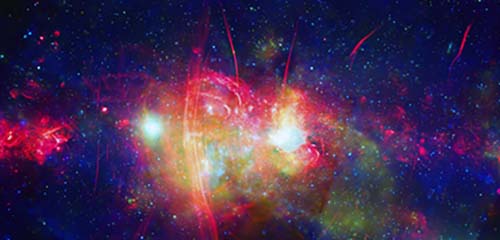
Near the center of the Milky Way, in a vast cloud in the space between the stars, astronomers have identified an organic molecule never before detected in the interstellar medium. It's called propargylimine, and it could play a key role in the formation of the amino acids vital for the emergence of life.
Thermonuclear Explosion in Sagittarius Constellation Is One of the Brightest Ever Recorded Live Science - November 12, 2019
The explosion lasted 20 seconds and emitted as much energy as the sun does in 10 days. Many millions or billions of years ago, a gargantuan star in the Sagittarius constellation named J1808 ran out of fuel, collapsed under its own weight and exploded. Blasts like this are common in the cosmos; scientists know they're part of a process that transforms mighty suns into shriveled neutron stars - the smallest and densest stars in the universe.
What has astronomers intrigued about J1808 today, however, is the fact that it's still exploding, and apparently showering our galaxy with some of the most intense blasts of light ever detected. On Aug. 20, 2019, a special neutron-star-watching telescope aboard the International Space Station (ISS) recorded a thermonuclear explosion on J1808 that blew all previously detected explosions away. The brief burst of X-ray light flickered for just 20 seconds, but released more energy in that time than Earth's sun releases in 10 days, according to a NASA news release. It was the single brightest flash of energy ever recorded by the telescope, which went online in 2017.
'Renegade' White Dwarf Survived a Supernova. Now It's Warping the Little Dipper Before Our Eyes. Live Science - July 11, 2019
There's a rebellious, half-dead star in the Little Dipper that's hellbent on escaping our galaxy - and now, astronomers have an idea why. The star, a small white dwarf that's moving incredibly fast toward the edge of the galaxy, may be one of just a handful of known white dwarfs that exploded in supernovas and lived to tell the tale, according to a study published June 21 in the journal Monthly Notices of the Royal Academic Astronomical Society. This unusual star, named LP 40-365 is a "partly burnt runaway remnant," suggesting that a peculiar, weaker-than-average supernova rendered the star much smaller, faster and toastier than a typical white dwarf. Strange as it appears, this stellar oddity may not be alone. Read more
Strange 'rogue planet' travels through space alone CNN - August 7, 2018
A strange 200 million-year-old object with the mass of a planet has been discovered 20 light-years from Earth, outside our solar system. The "rogue," as it's referred to by researchers, is producing an unexplained glowing aurora and travels through space alone, without a parent star. The object, named SIMP J01365663+0933473, has 12.7 times the mass of the gas giant Jupiter, the largest planet in our solar system. It also has a strong magnetic field that is more than 200 times stronger than Jupiter's. The temperature on its surface is more than 1,500 degrees Fahrenheit. Although this sounds hot, it's quite cool compared with the sun's surface temperature of about 9,932 degrees Fahrenheit. So what exactly is this rogue object?
Huge rogue 'planet' has magnetic field scientists can't explain
'Roundest known space object' identified BBC - November 18, 2016
Astronomers claim to have discovered the roundest object ever measured in nature. Kepler 11145123 is a distant, slowly rotating star that's more than twice the size of the Sun. Researchers were able to show that the difference between its radius as measured to the equator and the radius measured to the poles was just 3km. "This makes Kepler 11145123 the roundest natural object ever measured," said lead author Prof Laurent Gizon. He added that it was "even more round than the Sun".
Closest potentially habitable planet to our solar system found CNN - August 24, 2016
In a discovery that has been years in the making, researchers have confirmed the existence of a rocky planet named Proxima b orbiting Proxima Centauri, the closest star to our sun, according to a new study. It is the closest exoplanet to us in the universe. Given the fact that Proxima b is within the habitable zone of its star, meaning liquid water could exist on the surface, it may also be the closest possible home for life outside of our solar system, the researchers said. Because of its location, the researchers hope that it provides an opportunity to "attempt further characterization via ongoing searches by direct imaging and high-resolution spectroscopy in the next decades, and possibly robotic exploration in the coming centuries."
Found! Potentially Earth-Like Planet at Proxima Centauri Is Closest Ever Live Science - August 24, 2016
Astronomers have discovered a roughly Earth-size alien world around Proxima Centauri, which lies just 4.2 light-years from our own solar system. What's even more exciting, study team members said, is that the planet, known as Proxima b, circles in the star's "habitable zone" - the range of distances at which liquid water could be stable on a world's surface.
A new Einstein Ring: Distant galaxy lensed by gravity Science Daily - June 2, 2016
A multinational team of astronomers has found an Einstein Ring, a rare image of a distant galaxy lensed by gravity. In his seminal general theory of relativity published a century ago, Albert Einstein predicted that gravity would distort the fabric of spacetime, and that light would follow curved paths as a result. Astronomers first observed this effect in 1919, by measuring the position of stars near the Sun during the 1919 total solar eclipse, and noting a slight shift resulting from the gravitational field of our nearest star. On a larger scale, light from distant galaxies is bent by black holes and massive galaxies that lie between them and Earth. The intervening objects act as lenses, creating arcs and 'Einstein rings' of light.
Manchester astronomers detect precious element in space PhysOrg - May 13, 2016
A team of astronomers have detected a rare gas 4000 light years away from Earth. The discovery could help scientists to understand more about the history of this important element. Helium-3 is a gas that has the potential to be used as a fuel in nuclear fusion power plants in the future, and is crucial for use in cryogenics and medical imaging techniques. There is very little of it available on Earth, so most of it is manufactured in nuclear laboratories at great cost. There are thought to be significant supplies on the Moon, and several governments around the world have signaled their intention to go to there to mine it, which could trigger a new space race.
Most eccentric planet ever known flashes astronomers with reflected light Science Daily - March 19, 2016
A team of astronomers has spotted an extrasolar planet that boasts the most eccentric orbit ever seen. The planet moves in a flattened ellipse, traveling a long path far from its star and then making a fast slingshot around the star at its closest approach. Researchers detected a 'flash' of starlight bouncing off the planet's atmosphere as it made its closest orbital approach to its star.
Looking to the Stars of Australian Aboriginal Astronomy Ancient Origins - December 30, 2015
Astronomy played an important role in many ancient societies. Through this natural science, the ancients were able to make calendars, navigate during the night, and even explore the nature of the universe through mythology and philosophy. Some civilizations well-known for their astronomical developments include the Babylonians, the ancient Egyptians, and the ancient Greeks. The astronomy of many other cultures, however, has been side-lined, as a result of the prevailing Euro-centric view of astronomy, and civilization, in general. One of these is the astronomy of the Australian Aboriginal people, considered by some to be the oldest in the world.
Moon's Age Revealed, and a Lunar Mystery May Be Solved Live Science - April 3, 2014
Scientists have pinned down the birth date of the moon to within 100 million years of the birth of the solar system - the best timeline yet for the evolution of our planet's natural satellite. This new discovery about the origin of the moon may help solve a mystery about why the moon and the Earth appear virtually identical in makeup, investigators added. Scientists have suggested the moon was formed 4.5 billion years ago by a gigantic collision between a Mars-size object named Theiaand Earth, a crash that would have largely melted the Earth. This model suggested that more than 40 percent of the moon was made up of debris from this impacting body. Current theory suggests that Earth experienced several giant impacts during its formation, with the moon-forming impact being the last.
Gravity measurements confirm subsurface ocean on Saturn's moon Enceladus Science Daily - April 3, 2014
In 2005, NASA's Cassini spacecraft sent pictures back to Earth depicting an icy Saturnian moon spewing water vapor and ice from fractures, known as "tiger stripes," in its frozen surface. It was big news that tiny Enceladus - a mere 500 kilometers in diameter - was such an active place. Since then, scientists have hypothesized that a large reservoir of water lies beneath that icy surface, possibly fueling the plumes. Now, using gravity measurements collected by Cassini, scientists have confirmed that Enceladus does in fact harbor a large subsurface ocean near its south pole, beneath those tiger stripes.
Icy body found orbiting far from Sun BBC - March 26, 2014
Scientists have identified a new dwarf planet in the distant reaches of our Solar System. It is being called 2012 VP113 for the time being, is about 450km across and is very likely icy in composition. To date, only one other such object has been seen orbiting beyond the major planets in its region of space referred to as the inner Oort Cloud. That previous object, called Sedna, is about 1,000km across, and was found 10 years ago. But researchers believe there are hundreds more such objects awaiting detection.
Icy Chariklo asteroid has ring system BBC - March 26, 2014
>
The asteroid Chariklo has been confirmed as the smallest object in the Solar System to display a ring system. Encircling bands of material are more usually associated with the giant planets, such as Saturn and Uranus. Chariklo may be just 250km wide but observations made when it passed in front of a distant star reveal the presence of two distinct rings.
On Venus, Rainbow-Like 'Glory' Seen for 1st Time (Photos) Live Science - March 26, 2014
Scientists have captured shimmering rainbow colors above Venus for the first time using a European spacecraft currently orbiting the cloud-covered planet. The new Venus photos mark the first time that a rainbow-like "glory" has been photographed on another world besides the Earth, officials with the European Space Agency (ESA) announced this month. The phenomenon also pointed to a mystery in the hothouse planet's atmosphere, they added. ESA's Venus Express spacecraft captured a 746-mile (1,200 kilometer) glory on Feb. 24, 2011 that happened when the sun shone on sulfuric acid droplets atop the atmosphere. The phenomenon was spotted about 43 miles (70 kilometers) above Venus' surface after researchers took pictures of the clouds with the sun directly behind the spacecraft.
Kepler telescope bags huge haul of planets BBC - February 27, 2014
The science team sifting data from the US space agency's (Nasa) Kepler telescope says it has identified 715 new planets beyond our Solar System. This is a huge new haul. In the nearly two decades since the first so-called exoplanet was discovered, researchers had claimed the detection of just over 1,000 new worlds. Kepler's latest bounty are all in multi-planet systems; they orbit only 305 stars. The vast majority, 95%, are smaller than our Neptune, which is four times the radius of the Earth. Four of the new planets are less than 2.5 times the radius of Earth, and they orbit their host suns in the "habitable zone" - the region around a star where water can keep a liquid state.
'Biggest observed meteorite impact' hits Moon BBC - February 24, 2014
>
Scientists say they have observed a record-breaking impact on the Moon. Spanish astronomers spotted a meteorite with a mass of about half a tonne crashing into the lunar surface last September. They say the collision would have generated a flash of light so bright that it would have been visible from Earth. "This is the largest, brightest impact we have ever observed on the Moon," said Prof Jose Madiedo, of the University of Huelva in south-western Spain. The explosive strike was spotted by the Moon Impacts Detection and Analysis System (Midas) of telescopes in southern Spain on 11 September at 20:07 GMT.
'Oldest star' found from iron fingerprint PhysOrg - February 10, 2014
A team of astronomers has discovered the oldest known star in the Universe, which formed shortly after the Big Bang 13.7 billion years ago. The discovery has allowed astronomers for the first time to study the chemistry of the first stars, giving scientists a clearer idea of what the Universe was like in its infancy. As the Big Bang's name suggests, the universe burst into formation from an immense explosion, creating a vast soup of particles. Gigantic clouds of primordial soup, made mainly of hydrogen and helium, eventually collapsed to form the first stars - massive, luminous, short-lived objects that exploded as supernovae soon after. In the wake of such explosions, gas clouds gave rise to a second generation of stars that telescopes can still pick out today. Scientists have thought that the first stars in the universe burst with tremendous energy, spewing out the first heavy elements, such as carbon, iron, and oxygen. But according to new research from MIT, not all of these first stars may have been forceful exploders.
Exceptionally close stellar explosion discovered Science Daily - January 27, 2014
An exceptionally close stellar explosion discovered on Jan. 21 has become the focus of observatories around and above the globe, including several NASA spacecraft. The blast, designated SN 2014J, occurred in the galaxy M82 and lies only about 12 million light-years away. This makes it the nearest optical supernova in two decades and potentially the closest type Ia supernova to occur during the life of currently operating space missions.
Herschel Telescope Detects Water On Dwarf Planet in Asteroid Belt Science Daily - January 22, 2014
Scientists using the Herschel space observatory have made the first definitive detection of water vapor on the largest and roundest object in the asteroid belt, Ceres. Plumes of water vapor are thought to shoot up periodically from Ceres when portions of its icy surface warm slightly. Ceres is classified as a dwarf planet, a solar system body bigger than an asteroid and smaller than a planet.
Cosmic Lens Caught Bending Bright Gamma-Ray Burst, a Space First Live Science - January 22, 2014
A telescope in space has captured a rare kind of cosmic alignment for the first time. NASA's Fermi telescope has captured the first gamma-ray measurements of a gravitational lens, a rare natural alignment in which a massive body distorts light from a more distant object. A team of international astronomers used the observatory to study the emission from one galaxy as its energetic emissions passed through another spiral galaxy on their way toward Earth.
Milky Way may have formed 'inside-out': Gaia provides new insight into Galactic evolution PhysOrg - January 20, 2014
A breakthrough using data from the Gaia-ESO project has provided evidence backing up theoretically predicted divisions in the chemical composition of the stars that make up the Milky Way's disc - the vast collection of giant gas clouds and billions of stars that give our Galaxy its 'flying saucer' shape.
Milky Way shaken... and stirred PhysOrg - January 20, 2014
A team of scientists headed by Ivan Minchev from the Leibniz Institute for Astrophysics Potsdam (AIP), has found a way to reconstruct the evolutionary history of our galaxy, the Milky Way, to a new level of detail. The investigation of a data set of stars near the Sun was decisive for the now published results. The astronomers studied how the vertical motions of stars - in the direction perpendicular to the galactic disc - depend on their ages. Because a direct determination of the age of stars is difficult, the astronomers instead analyzed the chemical composition of stars: an increase in the ratio of magnesium to iron points to a greater age.